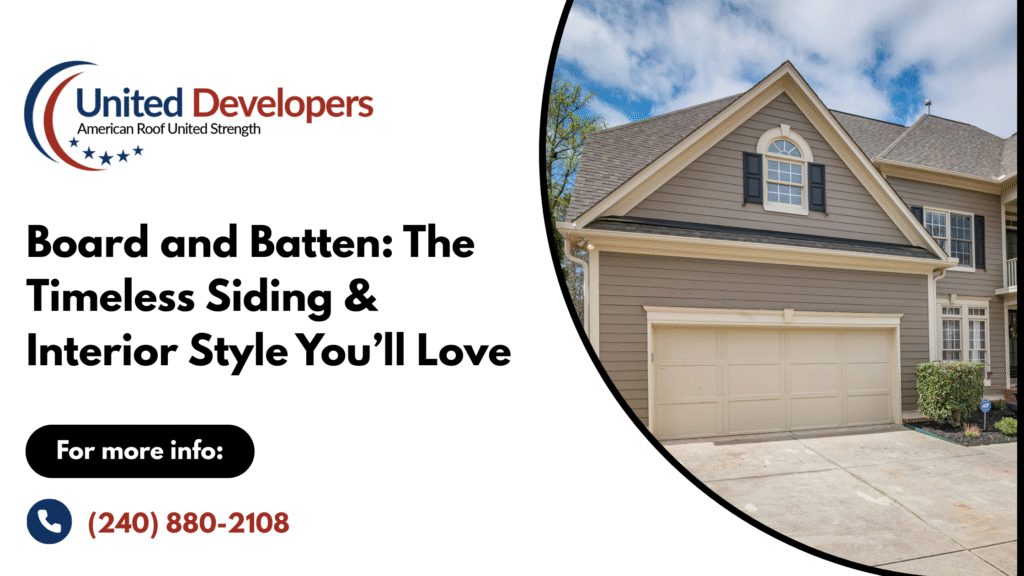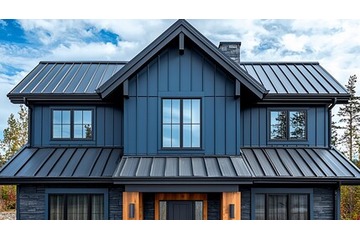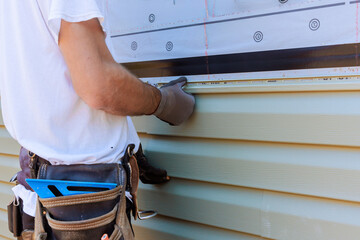Board and Batten is a timeless design that blends rustic charm with modern appeal. Whether used for siding or interior walls, this style adds depth, character, and elegance to any space. Homeowners love it for its versatility and ability to elevate both classic and contemporary designs.
In this blog, we’ll explore what board and batten is, its benefits, styles, costs, and creative design ideas. From exterior siding that boosts curb appeal to interior walls that add texture, you’ll find everything you need to transform your home with this enduring trend.

Table of Contents
What is Board and Batten siding?
Board and batten siding is a construction style that combines wide wooden planks with narrow strips that cover the seams between them. The wide planks, or boards, form the base, while the narrow strips, known as battens, are placed over the gaps to create a layered effect.
This method started as a practical way to make barns and houses more weatherproof, but over time, it became an architectural style in its own right. Today, it is used both outdoors and indoors, admired for its balance of rustic charm and modern sophistication.
The Origins of a Classic Design
The story of this siding begins centuries ago in rural Europe. Farmers and carpenters needed a simple, effective method to shield buildings from wind, rain, and snow. By placing vertical boards side by side and covering the spaces between them with battens, they created walls that were sturdier and better insulated.
What started as necessity soon became a style. People noticed how the vertical lines added rhythm and structure to buildings, giving them an appearance of height and elegance. Over the decades, what was once a humble method of construction became a symbol of tradition, authenticity, and good design.
How the Design Works
At its core, this style relies on two elements: the wide boards and the narrow battens. When combined, they produce clean vertical lines that play with light and shadow. The look is distinctive yet simple, which is why it adapts so well to both rustic and contemporary homes.
The materials have evolved significantly. Traditional wood is still used, but modern versions include vinyl, fiber cement, engineered wood, and even metal. Each option brings its own set of advantages, from the warmth of natural timber to the durability of low-maintenance alternatives.
Exterior Applications
On the outside of a house, this siding makes a bold statement. It is particularly popular with the modern farmhouse trend, but its versatility extends far beyond. Cottages, suburban houses, and even sleek urban residences benefit from the vertical structure it provides.
The visual appeal is only part of the story. Durability plays a big role as well. With materials like fiber cement or vinyl, homeowners get the classic look without the constant upkeep required by wood. Color choices further expand the possibilities. White siding with black trim recalls classic farmhouses,
Interior Applications
Inside the home, this design has found a new purpose. Rather than covering entire structures, it is often used to create accent walls or add depth to plain spaces. A living room wall behind a sofa, a bedroom wall behind the bed, or a hallway that needs extra character can all benefit from the layered look.
The effect indoors is subtle but powerful. Vertical lines give the impression of added height, while painted finishes allow homeowners to match any theme. Neutrals like white and beige create calm, classic spaces, while bold colors such as green or navy introduce drama.
Materials in Detail
One of the strengths of this style is the wide variety of materials available today:
- Wood brings warmth and authenticity but requires frequent maintenance to prevent rot, warping, or pest damage.
- Vinyl offers a budget-friendly, low-maintenance option, though it may not match the natural beauty of timber.
- Fiber Cement combines durability with resistance to pests, fire, and moisture, making it ideal for long-term use.
- Engineered Wood provides a middle ground between natural aesthetics and enhanced strength.
- Metal gives a bold, industrial edge, favored in modern architecture for its sleek appearance and resilience.
Choosing the right material depends on budget, maintenance expectations, and the desired look. Each option has its advantages, but all maintain the core visual rhythm that makes this siding instantly recognizable.
Comparisons with Other Styles
To understand why this design remains special, it helps to compare it with other popular siding styles. Shiplap, for example, places horizontal boards side by side, overlapping slightly to create a watertight seal. While shiplap emphasizes width and horizontal flow, board and batten emphasizes height and verticality.
Clapboard siding, another classic, uses long horizontal planks that overlap downward. It too is practical and traditional, but it produces a completely different visual effect. Where clapboard makes homes appear broader and shiplap feels rustic, board and batten feels tall, structured, and elegant.
Benefits and Drawbacks
On the positive side, it is versatile, stylish, and adaptable. It suits both historic farmhouses and sleek modern homes. Its layered design is durable, and with the right materials, it can withstand harsh climates. Indoors, it transforms plain rooms into visually engaging spaces.
On the downside, wood versions require significant upkeep. Even with modern alternatives, installation can be more complex than flat siding styles. Costs vary widely depending on the chosen material, and while vinyl or engineered options may be affordable, premium fiber cement.
Cost Considerations
When planning a project, budget plays a critical role. Exterior applications typically cost more, as they involve large surface areas and require weatherproof materials. Wood siding often needs sealing and repainting, adding to long-term expenses. Vinyl and fiber cement versions, though pricier upfront, can save money over time.
Interior applications, by contrast, are often more affordable. A single accent wall can be completed as a DIY project with inexpensive materials like MDF or pine. Hiring professionals increases costs, but the polished results often justify the investment.
Overall, costs vary significantly based on material, labor, and project size. Homeowners must weigh short-term savings against long-term durability to choose the best option.
Design Inspirations
One of the joys of working with this siding is its adaptability. For a farmhouse-inspired look, classic white walls with black trim remain a timeless choice. Those seeking modern flair may opt for deep navy, charcoal, or even black, paired with light furniture for contrast.
Two-tone exteriors have become increasingly popular, often combining horizontal lap siding on the lower level with board and batten on the upper. This mix creates balance and adds architectural interest. Indoors, painted battens that match the wall color produce subtle texture.
Maintenance and Longevity
Proper maintenance is essential to ensure this design lasts for decades. Wood must be regularly inspected for rot, pests, and weather damage, with repainting or staining required every few years. Vinyl and fiber cement need far less attention, usually just an occasional wash with water.
Indoors, painted walls are easier to maintain, especially when durable finishes like satin or semi-gloss are used. Minor scuffs or marks can be touched up with paint, keeping the wall looking fresh for years.
Why It Remains Timeless
The enduring popularity of this design lies in its ability to bridge tradition and modernity. It carries the history of rural barns and farmhouses while fitting seamlessly into contemporary architecture. Its vertical lines create elegance, its adaptability supports countless styles, and its authenticity ensures it never feels artificial.
Few design choices have the power to remain relevant across centuries, but this one does. Whether used as an entire exterior finish or a single accent wall, it adds depth, character, and personality to any space.
Final Thoughts
Board and batten is more than a construction technique; it is a design language that has stood the test of time. From its humble beginnings in European barns to its place in today’s modern homes, it continues to inspire homeowners, builders, and designers alike.
For those seeking a balance of function and beauty, history and modernity, subtlety and boldness, this siding offers it all. Its story proves that the simplest designs often have the greatest staying power. With countless material options it is one of the most versatile styles available.


